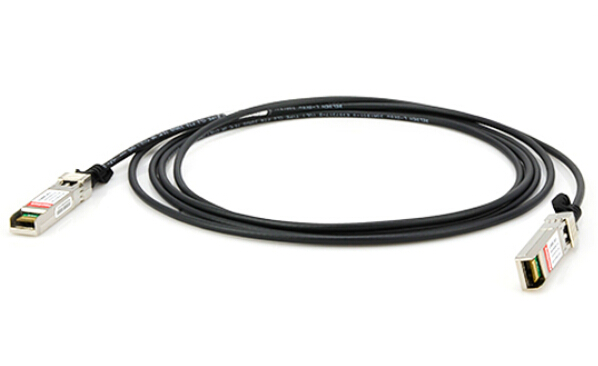10:16 AM SFP+ Cable Interconnect Assemblies Overview | ||||||||||||
Introduction SFP+ passive copper cable assemblies were developed specifically as a costeffective and lower-power alternative to optical fiber cables for short reach links in high-speed interconnect applications such as high performance computing (HPC), data center networking and network storage markets. The assemblies support data transfer rates up to 10 Gb/s per lane, meeting or exceeding current Industry Standard Specifications. These SFP+ fully-shielded assemblies combine twin-axial shielded cable with robust die cast connector interfaces for enhanced support of high frequency data rates. Description SFP+ passive copper cable assemblies use twin-axial (twinax) shielded cable, which means that the signals travel over parallel pairs of conductors that have foil shields over each pair with a drain wire interstitial to the conductors. The cable contains 2 pairs, one for transmit (Tx) and one for receive (Rx) and each shielded pair is surrounded by an overall shield. Twinax cable has all of the noise cancelling characteristics of twisted-pair cable with the added benefits of homogeneous geometry, which means that the cable's 100 ohm impedance is much better controlled resulting in less signal loss.  These assemblies are called passive copper cables because there isn't any signal conditioning circuitry (e.g. crosstalk or echo cancellation) contained within the SFP+ connector. Sometimes these assemblies are referred to as DAC or Direct Attached Copper cables or Cu cables. Inside the SFP+ MSA footprint optical cables can be used that require optical tranceivers or Active Optical Cables (AOC) that contain the transceiver as part of the cable. There are four wire gauges to support our SFP+ passive copper cable assemblies: 30, 28, 26 and 24 AWG. These gauge offerings are based on the attenuation limits within the governing standards; longer cables require larger gauge copper wire. SFP+ connectors contain EEPROMs within the connector's diecast metal backshell. An EEPROM is an "Electrically Erasable Programmable Read-Only Memory" chip that is programmed at the factory with specific information about the cable assembly. This information is used by the network equipment that the cable is plugged into to get information that is used for signal transmission as well as information about the cable assembly such as vendor, serial number, part number, etc. Applications and Compatibility The initial interface option for 10 Gigabit Ethernet (10GbE) switches and servers were SFP+ ports because the 10GBASE-T standard and products were still being developed. As a result, there are many existing 10GbE switches and servers on the market that support SFP+ cabling. The SFP+ ports allow SFP+ direct attach (DAC) passive copper cable assemblies or SFP+ optical fiber modules to be used within the same port. The choices between SFP+ passive copper or active optical fiber are based on reach or the distance between the ports that are being connected as well as user preference. The passive SFP+ cable has a maximum reach of 5 meters which allows for Top of Rack (ToR) configurations and may also support Middle of Row (MoR) deployments as explained below. The SFP+ DAC performance advantages over 10GBASE-T include lower latency and slightly lower power. SFP+ interfaces take approximately the same space on a switch front panel as the RJ45 connector and, with SFP+ interfaces, switches can be built with 32 or 48 ports of 10 GbE in a single rack-unit height.  Some equipment vendors discourage the use of 3rd party cable assemblies by issuing a warning message if a non-vendor approved cable is plugged into a port. Most vendors, however, will provide a "work around". Some errors are simple to clear just by acknowledging brand messaging. Fiberstore's SFP+ direct attached passive copper cables have been tested by the University of New Hampshire's Interoperability Lab (UNH IOL) and passed their 10Gigabit Ethernet interoperability testing with several vendors' devices including: Cisco, Dell, Arista and Brocade. Connectivity Options
| ||||||||||||
|
|
| Total comments: 0 | |
